Champagne, Champagne
I love those little bubbles
Champagne, Champagne
Though they get me into trouble
Lord, how I wish it would rain
Champagne, Champagne, Champagne
~Dada
Who doesn’t love Champagne? The sound the cork makes as it pops. The tiny bubbles as they rise up your glass. What’s not to love? Aside from the beauty and awe of the bubbles, it all comes down to science!Click To Tweet
Tickle Your Nose
Bubbles are carbonation and carbonation means Carbon Dioxide [CO2]. It’s a gas, so it rises. Depending on the glass it will continue to rise at a different pace and length of time. when it comes to Champagne or sparkling, the glass matters!Click To Tweet
Long story made short, tall, narrow glasses will keep your bubbles lasting longer than wide-mouthed ones.
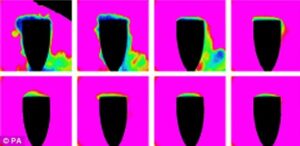
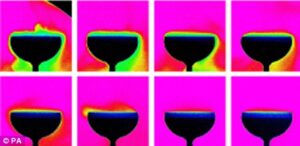
The above infrared images demonstrate how the CO2 is released from the champagne surface. Carbon dioxide irritates the sensory nerves in the nose. This leads to the popular tingling sensation of sparkling wines.
Research shows that the levels of the gas close to the edge of a flute were two to three times higher than those reached above the coupe. So glass matters to you! Do you like the tingle- go with a flute. Not a fan of it, choose a coupe.
You’ll Shoot Your Eye Out
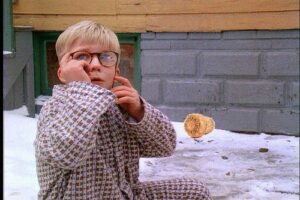
How many of us has had a Champagne cork get away from us? I was at a party once and popped a cork and it literally went two stories high! [Damn, I wish I had that on video!] Ever wonder why that happens?
Legally, sparkling wine must be at least 1 ATM and greater than .392 CO2/100ml.Click To Tweet Most sparkling is actually under much more pressure (5-6 ATM) and in a closed container, the amount of CO2 in the head of the bottle is equal to the amount within the liquid. Once you open the container, that equilibrium is eliminated and there is an excess of gas in the liquid. The reason the cork flies is because some of the energy stored in the closed champagne bottle is released as kinetic energy. Kinetic energy is work energy and that is what sends the cork flying.
What’s the solution to shooting yours our a friend’s eye out, or maybe busting a window or two? All you have to do is make sure your sparkling wine is cold. The gas is inversely related to the temperature. That means the warmer the liquid that has the CO2, the larger the gas release is; so the cork will fly further. As the temperature cools, the CO2 becomes more soluble in the liquid, so less escapes when the cork is opened, causing less of a dramatic pop!
Double Your Pleasure
 We all know wine goes through fermentation. The chemical breakdown in which sugars are converted into ethyl alcohol is fermentation. Carbon dioxide is released during this process. So why doesn’t all wine have effervescence like sparkling? It’s the second fermentation. The wine goes through the first fermentation until dry, like other wines, but then more sugar is added for the second fermentation inside a closed container.
We all know wine goes through fermentation. The chemical breakdown in which sugars are converted into ethyl alcohol is fermentation. Carbon dioxide is released during this process. So why doesn’t all wine have effervescence like sparkling? It’s the second fermentation. The wine goes through the first fermentation until dry, like other wines, but then more sugar is added for the second fermentation inside a closed container.
Note that I said, ‘closed container’ and not in bottle. That are significant differences in the winemaking process. Not all sparkling wine goes through a second fermentation in bottle. There are three methods of second fermentation. Which method used determines the quality of the wine and the size of the bubbles.
The Label Tells It All
The most labor intensive method is Methode Champenoise (Traditional
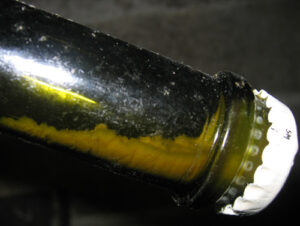
Method.) All Champagne uses this process. It involves taking the cuvee (base wine) and tirage (sugar, wine and yeast) and putting it into the bottle. In this method, the bottle itself is the fermenting vessel. The second fermentation takes between one and three months. Labeling will either read Methode Champenoise, if Champagne or “fermented in this bottle.”
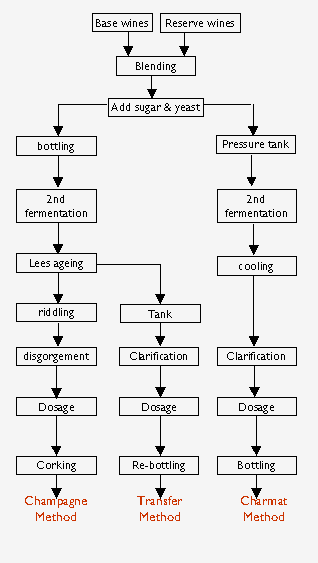
Transfer Process is much cheaper because there is no riddling. Emptying bottles into a transfer tank under pressure eliminates the CO2 loss during filter and dosage. “Fermented in a bottle” or “bottle fermented” is found on these labels.
Charmat Process also known as Methodo Italiano or Bulk Process is the least expensive way to make sparkling wine. In this method, the second fermentation is done in a tank. It is very rapid and extremely uniform. The CO2 is injected into the cuvee. There typically is no aging on lees, therefore you get no yeasty flavor. You also get much larger bubbles.
Sweetness Scale
When it comes to sipping bubbles, there are six levels of sweetness to choose from.
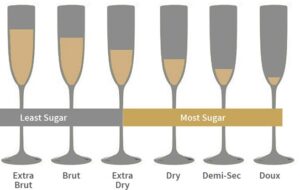
- Extra Brut (less than 6 grams of residual sugar per litre)
- Brut (less than 12 grams)
- Extra Dry (between 12 and 17 grams)
- Sec (between 17 and 32 grams)
- Demi-sec (between 32 and 50 grams)
- Doux (50 grams)
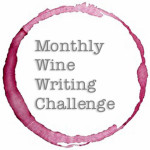 These are the posts that I love the best. When I get to combine my two passions, science and wine. I love being able to combine the two and I hope you enjoy reading as much as I cherish writing them. And when I can write a post that I love and make it my submission for the #MWWC27, that’s the trifecta!
These are the posts that I love the best. When I get to combine my two passions, science and wine. I love being able to combine the two and I hope you enjoy reading as much as I cherish writing them. And when I can write a post that I love and make it my submission for the #MWWC27, that’s the trifecta!
The monthly wine writer’s challenge is a friendly wine writing competition started by Jeff of thedrunkencyclist.com. The winner of each month chooses the next month’s theme. It always intrigues me how a single topic can be viewed differently by each of the writers and I always love reading their posts. You can read the posts and vote for your favorite here.
~Slainte!

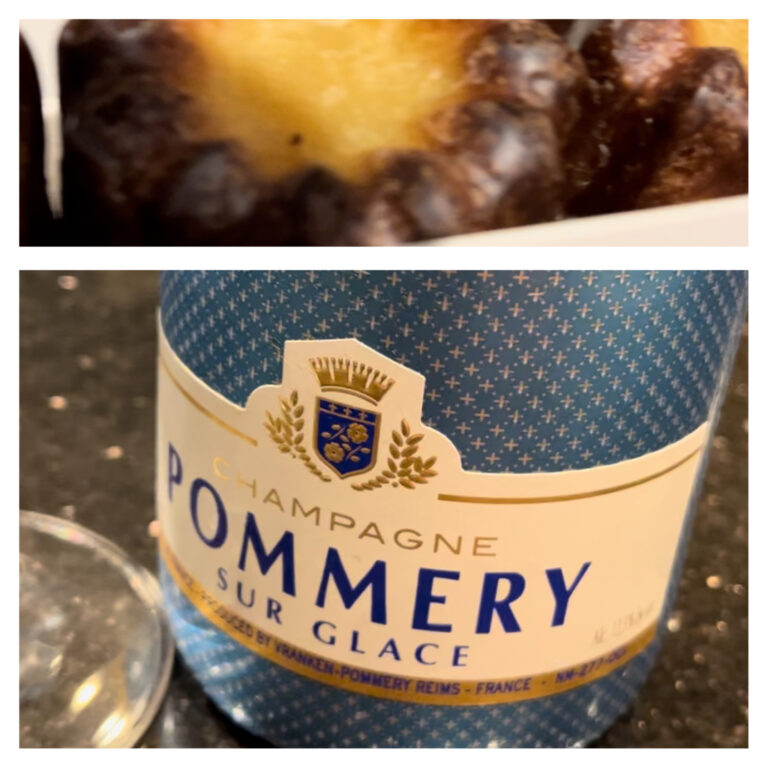
Great stuff here! Fun & informing…
Cheers!
Thank you Jill
If only chemistry class had been this much fun! Love how you integrate your science background into your love of wine.
Thank you so much Lauren. They really are my favorite posts to write.